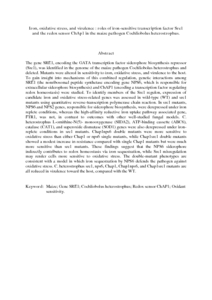Citation
Zhang, Ning and Mohd Zainuddin, Nur Ain Izzati and Scher, Keren and Condon, Bradford J. and Horwitz, Benjamin A. and Turgeon, B. Gillian
(2013)
Iron, oxidative stress, and virulence : roles of iron-sensitive transcription factor Sre1 and the redox sensor ChAp1 in the maize pathogen Cochliobolus heterostrophus.
Molecular Plant-Microbe Interactions, 26 (12).
pp. 1473-1485.
ISSN 0894-0282
Abstract
The gene SRE1, encoding the GATA transcription factor siderophore biosynthesis repressor (Sre1), was identified in the genome of the maize pathogen Cochliobolus heterostrophus and deleted. Mutants were altered in sensitivity to iron, oxidative stress, and virulence to the host. To gain insight into mechanisms of this combined regulation, genetic interactions among SRE1 (the nonribosomal peptide synthetase encoding gene NPS6, which is responsible for extracellular siderophore biosynthesis) and ChAP1 (encoding a transcription factor regulating redox homeostasis) were studied. To identify members of the Sre1 regulon, expression of candidate iron and oxidative stress-related genes was assessed in wild-type (WT) and sre1 mutants using quantitative reverse-transcription polymerase chain reaction. In sre1 mutants, NPS6 and NPS2 genes, responsible for siderophore biosynthesis, were derepressed under iron replete conditions, whereas the high-affinity reductive iron uptake pathway associated gene, FTR1, was not, in contrast to outcomes with other well-studied fungal models. C. heterostrophus L-ornithine-N(5)- monooxygenase (SIDA2), ATP-binding cassette (ABC6), catalase (CAT1), and superoxide dismutase (SOD1) genes were also derepressed under iron-replete conditions in sre1 mutants. Chap1nps6 double mutants were more sensitive to oxidative stress than either Chap1 or nps6 single mutants, while Chap1sre1 double mutants showed a modest increase in resistance compared with single Chap1 mutants but were much more sensitive than sre1 mutants. These findings suggest that the NPS6 siderophore indirectly contributes to redox homeostasis via iron sequestration, while Sre1 misregulation may render cells more sensitive to oxidative stress. The double-mutant phenotypes are consistent with a model in which iron sequestration by NPS6 defends the pathogen against oxidative stress. C. heterostrophus sre1, nps6, Chap1, Chap1nps6, and Chap1sre1 mutants are all reduced in virulence toward the host, compared with the WT.
Download File
![[img]](http://psasir.upm.edu.my/30079/1.hassmallThumbnailVersion/Iron%2C%20oxidative%20stress%2C%20and%20virulence%20roles%20of%20iron-sensitive%20transcription%20factor%20Sre1%20and%20the%20redox%20sensor%20ChAp1%20in%20the%20maize%20pathogen%20Cochliobolus%20heterostrophus..pdf)  Preview |
|
PDF (Abstract)
Iron, oxidative stress, and virulence roles of iron-sensitive transcription factor Sre1 and the redox sensor ChAp1 in the maize pathogen Cochliobolus heterostrophus..pdf
Download (84kB)
| Preview
|
|
Additional Metadata
Actions (login required)
 |
View Item |

